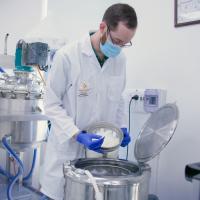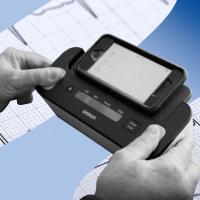A hundred years ago, scientists began researching how to make insulin using pancreases from dogs and cattle. Insulin has been used to treat people suffering with diabetes ever since, but it wasn’t until the 80s that genetic engineering allowed for the widespread distribution of this life-saving medicine.
In a healthy human body, insulin is a hormone created by the pancreas that controls glucose levels in the bloodstream. But a diabetic’s body doesn’t naturally produce insulin, which means the body can’t store glucose for later use as energy in fat cells.
Because of this, the fat cells break down and over-produce keto acids — the organic compounds responsible for converting glucose into energy — leading to acid levels that are too high for the liver to withstand. Should a diabetic not have access to insulin, this acid imbalance can trigger diabetic ketoacidosis, a life-threatening condition. This is why monitoring insulin levels and using medicine is critical to survival for diabetics.
Today, over seven million Americans with diabetes use at least one form of insulin to treat the disease, but many are at risk of not getting the care they need. The American Diabetes Association reported that 25% of patients have turned to self-rationing their medication to deal with its ever-increasing price tag.
Why is Insulin So Expensive?
The standard process for how to make insulin involves growing it in common bacteria, such as E. coli or yeast, with the help of an amino acid sequencing machine. It’s estimated that a vial of insulin costs pharmaceutical companies five to six dollars to manufacture, but because of a complicated web of regulations those companies are able to sell vials for $180-400.
Rising costs are nothing new. Insulin prices tripled from 2002 to 2013, and doubled between 2012 and 2016. To put this into perspective, in 1996 a vial of Humalog produced by Eli Lilly cost $21. Today, it’s priced at $324 despite the cost of production remaining steady. For those who rely on several vials per month, expenses can quickly end up in the thousands.
In the U.S. pharmaceutical industry, 90% of the global insulin market is owned by three companies: Novo Nordisk, Eli Lilly, and Sanofi. These companies essentially have a monopoly on the market; there is simply no competition to drive the price down. And further, their price increases have remained consistent with one another over time.
Every person with type I diabetes relies on insulin to survive, and many are willing to spend whatever it takes to get their necessary dosage. Big pharma is clearly taking advantage of this vulnerable part of the population, gorging themselves by charging astronomical costs and pricing out those who can’t afford to keep up.
Biohackers to Share How To Make Insulin With the Public
A group of dedicated biohackers believes that making insulin more accessible requires taking the monopoly away from the big three pharmaceutical companies that produce it. So they’ve started the Open Insulin Foundation, a non-profit with plans to develop the world’s first open-source insulin production model.
The team consists of dozens of volunteers led by founder Anthony DiFranco, a type I diabetic. They’re now able to produce the microorganisms needed for insulin with a bioreactor. They’re also working to develop equipment that can purify the proteins produced by the bioreactor.
With open-source hardware equivalent to proprietary bioreactors, the foundation hopes to give labs across the world access to the equipment needed to produce the insulin protein on a small scale.
“Very few people really have any concrete ideas about how to solve these problems,” says DiFranco. “At the level of the technical fundamentals, it’s clear that we can do this. And if we can, we must.”
But the process hasn’t been easy. For six years, DiFranco’s team has attempted to reverse-engineer the production of insulin with volunteer-led experiments at their community labs in cities like Oakland, Baltimore, and Sunnyvale, CA.
Today, they’re beginning to see hopeful signs of a major breakthrough — like getting an FDA-approved protocol for making injectables. The team estimates that costs will be 98% cheaper than big pharma, reaching prices as low as $5-15 per vial. The best part? They’re willing to give away their plans for how to make insulin for free.
“Our plan is to have a system for local production that can operate anywhere in the world that there is a need for it,” explains DiFranco. Open Insulin has already partnered with community labs, academic institutions, patient advocacy groups, and NGOs across the country and beyond.
They hope their work eventually leads to the distribution of insulin in countries that don’t currently have access to it. “There was a time for being angry,” says DiFranco. “Now that we can actually see an end to this soon, it’s not anger anymore. It’s just determination.”


